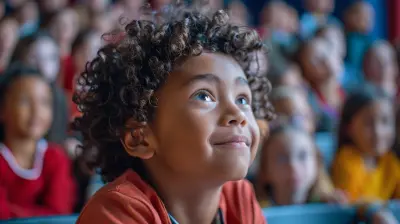How Storytelling Can Connect and Motivate Students
25 May 2025
Storytelling has been an essential part of human communication for centuries. From ancient cave paintings to bedtime fables, stories have shaped the way we understand the world. But did you know that storytelling can be a powerful tool in education too?
Think about it—when was the last time you remembered a boring textbook fact versus a compelling story? Chances are, the story stuck with you. That’s because stories engage our brains in a way that dry facts simply can’t.
In this article, we’ll dive into how storytelling can connect and motivate students, making learning more meaningful, exciting, and memorable.

Why Storytelling Matters in Education
Let's face it—students today have shorter attention spans than ever. The constant buzz of smartphones, social media, and video games makes traditional teaching methods less appealing. This is where storytelling comes in like a superhero.1. Stories Make Learning Personal
When students hear a story, they don’t just listen; they feel. A well-told story triggers emotions, making lessons more relatable. Imagine teaching about the American Revolution by simply listing dates and events. Now, contrast that with telling the story of a young soldier’s journey through the war. Which one do you think students will remember more?2. Boosts Engagement and Retention
Our brains are wired to remember stories. Studies show that when information is delivered in story form, retention rates increase significantly. Why? Because stories activate multiple areas of the brain—emotion, language, and even sensory processing. It’s like giving the brain a full workout instead of just hitting one muscle group.3. Helps Build Connections
Storytelling fosters a sense of connection—not just between teachers and students, but among the students themselves. A shared story can create empathy, spark discussions, and even encourage teamwork.Imagine a history class where students aren’t just reading about World War II but stepping into the shoes of a child living through it. Suddenly, history isn’t just a subject; it’s an experience.

How Storytelling Motivates Students
Motivation is one of the biggest challenges in education. How do you get students excited about a topic they might not initially care about? The answer: a great story.1. Inspires Creativity and Imagination
A good story paints vivid pictures in the minds of students. It forces them to think beyond the text and imagine scenarios, characters, and emotions. This sparks creativity, making lessons far more exciting than just reading from a textbook.2. Creates a Sense of Purpose
When students see themselves in a story, they connect with it on a deeper level. This can be particularly powerful when teaching moral values, leadership, or history.For instance, if a teacher tells the story of Malala Yousafzai’s journey, students don’t just learn about gender equality; they feel her struggle, courage, and determination. Suddenly, the lesson isn’t just a concept—it’s a cause.
3. Encourages Active Participation
Ever noticed how people lean in when listening to a compelling story? That’s because storytelling naturally draws people in. When teachers introduce storytelling techniques in class, students become active participants rather than passive listeners.They might start predicting what happens next, asking questions, or even sharing their own experiences. And that’s a sign of true engagement.

Practical Ways to Use Storytelling in the Classroom
Now that we know the power of storytelling, let’s talk about how you can actually use it in your classroom.1. Use Real-Life Stories
Nothing beats a true story. Whether it’s a historical event, a personal experience, or a real-world example, real-life stories add authenticity and credibility to lessons.For example, instead of teaching about perseverance in a generic way, share the story of Thomas Edison’s countless failures before inventing the light bulb. Suddenly, perseverance has a face and a meaning.
2. Turn Lessons Into Stories
Who says math or science can’t have stories? A math teacher might weave a detective-style mystery around solving equations. A science teacher could tell the story of an astronaut preparing for a space mission.By adding a narrative, even the most “boring” subjects become engaging.
3. Encourage Students to Tell Their Own Stories
Storytelling shouldn’t just come from the teacher. Encourage students to share their own experiences related to the subject. This makes learning interactive and gives students a sense of ownership over their education.For instance, in an English class, instead of just analyzing a novel, students could write their own short stories inspired by it. In a history class, they could create a diary entry from the perspective of a historical figure.
4. Use Multimedia Storytelling
We live in a digital age, so why not use digital storytelling? Videos, podcasts, and animations can bring stories to life in ways that text alone cannot. Tools like Storybird, Powtoon, or even simple PowerPoint animations can make storytelling more dynamic and interactive.5. Make It Interactive
Pause your story at key moments and ask students what they think happens next. Let them brainstorm different endings. Turn it into a class discussion. When students actively participate in the storytelling process, they become part of the learning itself.
The Science Behind Storytelling and Learning
If you’re wondering whether storytelling is just a trendy teaching trick, think again. Science backs it up.When we listen to stories, our brains release dopamine, the chemical responsible for motivation and emotional connection. This makes it easier for students to stay focused and remember what they learn.
Additionally, storytelling activates the mirror neurons in our brains, making us feel as though we’re experiencing the story ourselves. That’s why we cry during sad movies or cheer when the hero wins.
Final Thoughts
At the end of the day, education isn’t just about memorizing facts; it’s about understanding, feeling, and connecting. Storytelling transforms a classroom from a place of passive learning into a space of curiosity and engagement.So, whether you’re a teacher, a student, or even a parent, try weaving more stories into learning. It might just turn the spark of curiosity into a lifelong passion for knowledge.
all images in this post were generated using AI tools
Category:
Student EngagementAuthor:

Olivia Lewis
Discussion
rate this article
3 comments
Lorna Rocha
This article beautifully captures the power of storytelling in education. It truly highlights how narratives can inspire and foster deeper connections among students.
June 1, 2025 at 12:08 PM

Olivia Lewis
Thank you for your kind words! I'm glad you found the article resonant and appreciate the role of storytelling in education.
Sydney McMahon
This article highlights storytelling's transformative power in education; however, it should also address potential cultural biases in narrative techniques.
June 1, 2025 at 3:45 AM

Olivia Lewis
Thank you for your valuable feedback! I appreciate your point about addressing cultural biases and will consider it for future discussions on storytelling in education.
Evren Clayton
Stories ignite passion, inspire growth.
May 27, 2025 at 4:57 AM

Olivia Lewis
Absolutely! Stories have the power to spark interest and foster personal development in students by creating relatable experiences and evoking emotions.



